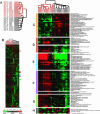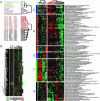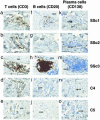Systemic and cell type-specific gene expression patterns in scleroderma skin
- PMID: 14530402
- PMCID: PMC218756
- DOI: 10.1073/pnas.1635114100
Systemic and cell type-specific gene expression patterns in scleroderma skin
Abstract
We used DNA microarrays representing >12,000 human genes to characterize gene expression patterns in skin biopsies from individuals with a diagnosis of systemic sclerosis with diffuse scleroderma. We found consistent differences in the patterns of gene expression between skin biopsies from individuals with scleroderma and those from normal, unaffected individuals. The biopsies from affected individuals showed nearly indistinguishable patterns of gene expression in clinically affected and clinically unaffected tissue, even though these were clearly distinguishable from the patterns found in similar tissue from unaffected individuals. Genes characteristically expressed in endothelial cells, B lymphocytes, and fibroblasts showed differential expression between scleroderma and normal biopsies. Analysis of lymphocyte populations in scleroderma skin biopsies by immunohistochemistry suggest the B lymphocyte signature observed on our arrays is from CD20+ B cells. These results provide evidence that scleroderma has systemic manifestations that affect multiple cell types and suggests genes that could be used as potential markers for the disease.
Figures




References
-
- Mayes, M. D. (1998) Semin. Cutan. Med. Surg. 17, 22–26. - PubMed
-
- Seibold, J. R. (2001) in Kelley's Textbook of Rheumatology, eds. Ruddy, S., Harris, E. D. & Sledge, C. B. (Saunders, Philadelphia), pp. 1211–1239.
-
- Steen, V. D. & Medsger, T. A., Jr. (2000) Arthritis Rheum. 43, 2437–2444. - PubMed
-
- Ferri, C., Valentini, G., Cozzi, F., Sebastiani, M., Michelassi, C., La Montagna, G., Bullo, A., Cazzato, M., Tirri, E., Storino, F., et al. (2002) Medicine (Baltimore) 81, 139–153. - PubMed
-
- Scussel-Lonzetti, L., Joyal, F., Raynauld, J. P., Roussin, A., Rich, E., Goulet, J. R., Raymond, Y. & Senecal, J. L. (2002) Medicine (Baltimore) 81, 154–167. - PubMed
Publication types
MeSH terms
Substances
Grants and funding
LinkOut - more resources
Full Text Sources
Other Literature Sources
Medical
Molecular Biology Databases

